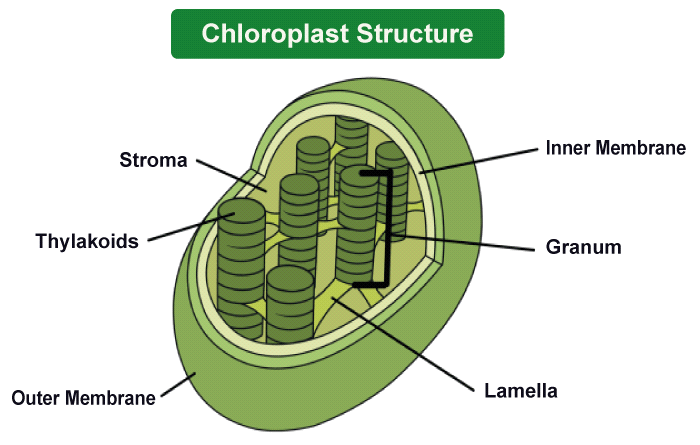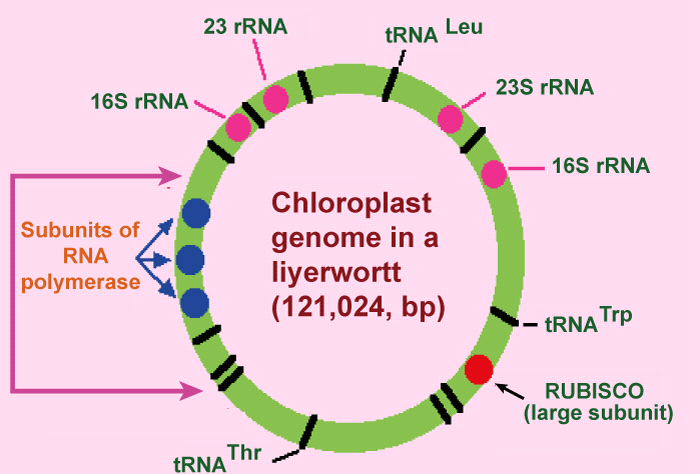Chloroplast DefinitionThe term "Chloro" is often associated with the colour green. It raises the question of whether it is the same as chlorophyll, which is also related to green pigments in plants. However, while both terms are linked to plant biology and photosynthesis, they refer to different things. Chloro represents the colour green, whereas chlorophyll refers explicitly to a pigment found in chloroplasts that gives them their green colour. Chloroplasts are specialized organelles within plant cells that perform an essential role in photosynthesis. During the process of photosynthesis, chloroplasts help to convert light energy from the sun into chemical energy for the plants. This process involves several complex metabolic activities, such as synthesizing fatty acids, tetrapyrroles (such as heme), membrane lipids, starches and hormones - all of which are crucial for plant growth and survival. Let us talk about the functions and process of Chloroplast in brief. What do you mean by Chloroplast?Chloroplasts are cell organelles identified in plant cells and few protists, such as algae as well as cyanobacteria. These organelles are known as plastids, which means they have the ability to store or produce various substances within a cell. Chloroplasts play a crucial role in the survival of plants by being responsible for producing food through photosynthesis. Photosynthesis is a complex process that involves converting light energy from the sun into sugar that can be used by the plant cell. This entire process occurs within chloroplasts, where high concentrations of chlorophyll molecules absorb light energy and give plants their characteristic green colour. Interestingly, like mitochondria, chloroplasts also have an evolutionary history with bacteria. Scientists believe both these organelles evolved from free-living bacteria engulfed by early eukaryotic cells millions of years ago. Significant facts regarding the ChloroplastChloroplasts are those effective organelles discovered in plant cells that play a necessary role in the procedure of photosynthesis. As we know, plants are autotrophs and producers because they can produce their food through this process. Chloroplasts contain a special pigment called chlorophyll, responsible for capturing sunlight and converting it into energy that the plant can use to carry out its metabolic processes. Plastids are another type of organelle present in most plant cells. They come in three types: chloroplasts, chromoplasts, and leucoplasts. While all plastids have double membranes and are involved with the preparation or storage of food material, each type has unique characteristics. Chloroplasts are plant organelles that contain chlorophyll, which captures sunlight and converts it into energy while releasing oxygen from water. Chromoplasts are plastids that have colours other than green due to pigments such as carotenoids or anthocyanins. These pigments give various hues to different parts of plants, like petals or fruits, which attract insects for pollination purposes. On the other hand, Leucoplasts do not have any colouration; they appear colourless under a microscope but still serve essential functions within the cell. One interesting fact about leucoplast is that it can be converted into Chloroplast when exposed to sunlight and reconverted back into leucoplast. Chloroplast CharacteristicsThese are round, oval or disk-shaped bodies that have specific characteristics that distinguish them from other types of plastids. One such characteristic is their green colour, which comes from two pigments known as chlorophyll a and b. The primary function of these pigments is to absorb light energy for the process of photosynthesis. In addition to chlorophyll, there are also other pigments present in chloroplasts, such as carotenoids that act as accessory pigments by trapping solar energy and passing it on to chlorophyll. Chloroplasts occur in all green tissues but are primarily concentrated in the parenchyma cells of leaf mesophyll. Chloroplasts typically measure 1-2 μm (1μm = 0.001 mm) thick and 5-7 μm in diameter. They have an envelope consisting of a double membrane with outer and inner layers between which lies an intermembrane space called the stroma lamellae. The thylakoid membrane is another unique feature found within chloroplasts - this internal membrane has extensively folded into closed disks called thylakoids. Plants have thylakoids that have stacked into grana connected by stromal lamellae. The thylakoid membrane surrounds a central aqueous region called the thylakoid lumen. However, the space between the inner and thylakoid membranes has filled with stroma containing enzymes, starch granules, and copies of the chloroplast genome. Chloroplast Structure
These oval-shaped structures have two membranes - an outer membrane, which forms the external surface of the Chloroplast, and an inner membrane that lies just beneath it. The space between these two membranes is called the intermembrane space, which is about 10-20 nanometers wide. The stroma has located within the innermost membrane of chloroplasts. Unlike mitochondria's inner membranes with many folds called cristae to absorb surface area, chloroplasts' inner membranes are smooth. However, they contain many tiny disc-shaped sacs known as thylakoids within their stroma. In vascular plants and green algae, these thylakoids stack on top of one another to form a granum. Thylakoids are essential for photosynthesis because they contain pigments such as chlorophylls and carotenoids that absorb light during this process. Chlorophyll molecules group together with other molecules like proteins to form complexes known as photosystems I and II, responsible for different parts of the light-dependent reactions. Photosynthesis involves light-absorbing pigments that form complexes called photosystems, which are of two types: photosystem I and II. The stroma is where enzymes synthesize complex organic molecules such as carbohydrates to store energy. Chloroplasts containing their DNA and ribosomes similar to those in bacteria evolved from free-living bacteria like mitochondria did in eukaryotic cells. Chloroplasts FunctionChloroplasts are an essential part of the plant and algal cells, responsible for carrying out the process of photosynthesis. It is a complex process that involves two stages: light-dependent reactions and light-independent reactions (also known as the Calvin cycle). During the first stage, chlorophyll and carotenoids capture sunlight to form ATP (the energy currency of the cell) and NADPH (which carries electrons). The second stage consists of CO2 fixation, where NADPH converts inorganic carbon dioxide into organic molecules in the form of carbohydrates. The importance of chloroplasts cannot be overstated; they play a crucial role in providing plants with energy to grow and survive. Without them, plants would not be able to carry out photosynthesis or produce food through this process. Interestingly, some plants no longer have chloroplasts due to their unique evolutionary adaptations. One example is Rafflesia, a parasitic plant genus that obtains nutrients from other plants - specifically Tetrastigma vines. Besides their primary function in photosynthesis, chloroplasts also play various regulatory parts within cells, such as participating in photorespiration processes. They also act as critical organelles for pathogen defence due to their association with other cellular components like the nucleus, cell membrane, and endoplasmic reticulum. In addition to this vital role played by chloroplasts, they are also part of various metabolic activities of plant cells, such as formation of membrane lipids, hormones, fatty acids, etc. Chloroplast GenomeLike mitochondria, chloroplasts contain DNA and reproduce independently from circular DNA through a division process similar to bacterial binary fission. The chloroplast genome is typically circular (though linear DNA has also been documented) and is approximately 120-200 kb in length. 
The chloroplast genome has been much reduced in size over the course of evolution, and an increasing number of chloroplast genes have been transferred to the nuclear genome. As a result, the nuclear genome is necessary to encode proteins that are responsible for Chloroplast's function. Chloroplast genomes (cpDNA) are relatively conserved among land plants in terms of their size, structure, and gene content. A study revealed that 81% of genes are shared between land plants and the most ancient algae species (Mesostigma Viride). Chloroplast genomes contain about 120 genes on average, including rRNA genes, tRNA genes, at least three subunits of prokaryotic RNA polymerases and some other protein-coding genes like thylakoid proteins and ribosomal proteins. Chloroplast DNA sequencing is a high-throughput sequencing of plant chloroplast genomes using Illumina or PacBio platforms to perform an in-depth analysis of cpDNA. Comparative genomic analysis obtains information including species classification, phylogenetic evolution, geographic lineage inheritance, disease diagnosis and forensics. ConclusionChloroplasts are responsible for photosynthesis in plants and algae, as they contain chlorophyll, which gives plants their green colour. They perform various metabolic activities, including the synthesis of fatty acids, starch, membrane lipids, hormones, and tetrapyrroles. Unlike animal or bacterial cells, plant cells produce their food through photosynthesis. While chloroplasts may seem small and insignificant at first glance, they play a vital role in the life cycle of plants and other organisms.
Next TopicComputer Software Definition
|
 For Videos Join Our Youtube Channel: Join Now
For Videos Join Our Youtube Channel: Join Now
Feedback
- Send your Feedback to [email protected]
Help Others, Please Share










